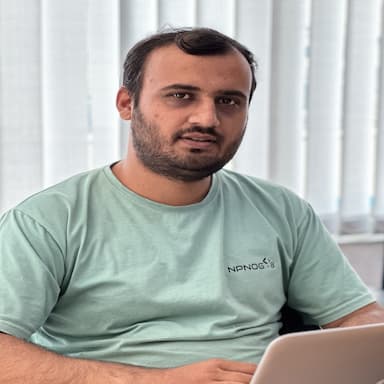Calendar and Venue
Date: June 15th to 20th, 2025
Time: 09:00 – 18:00 NPT (GMT+0545)
Venue: Hyatt Centric, Kathmandu, Nepal.
Workshop Details
1. ISP Core Masterclass
Trainers:
- Priya Ranjan Karn – Websurfer Nepal Communication System, HOD RnD – Lead Instructor
 Priya Ranjan has been working in the ISP industry since last 11 years. Currently he is associated with one of the leading ISPs of Nepal, Websurfer Nepal Communication System as an HOD of RnD Department, where he leads the company’s technical research team. His current role involves planning, designing and implementation of the MPLS, MPLS services and Peering Networks along with best practices implementation within the ASN. He has recently started to engage himself to the NOGs as an instructor, volunteer and Presenter.
Priya Ranjan has been working in the ISP industry since last 11 years. Currently he is associated with one of the leading ISPs of Nepal, Websurfer Nepal Communication System as an HOD of RnD Department, where he leads the company’s technical research team. His current role involves planning, designing and implementation of the MPLS, MPLS services and Peering Networks along with best practices implementation within the ASN. He has recently started to engage himself to the NOGs as an instructor, volunteer and Presenter.
- Dibya Khatiwada – PCH, APNIC Community Trainer

Dibya works as a Provisioning Manager at Packet Clearing House (PCH), responsible for interconnection of PCH’s DNS Anycast network with networks around the world meeting at different Internet eXchange Points. With over 10 years of experience in the field, Dibya has been an active contributor at local and regional events like npNOG, SANOG, APRICOT on a variety of topics such as Network Monitoring and Management, BGP routing and Internet of Things. Dibya shares his knowledge as a retained community trainer for APNIC.
- Aman Shrestha – Technical Manager,
 CG CommunicationsAman Shrestha is an experienced network engineer with over 12 years in the ISP industry. He served as Lead of Network Operations at Vianet Communications, where he was responsible for the planning, design, and optimization of large-scale network infrastructures. Includes MPLS services, BGP routing, and implementing best practices in network architecture and operations to ensure high availability, scalability, and performance.
CG CommunicationsAman Shrestha is an experienced network engineer with over 12 years in the ISP industry. He served as Lead of Network Operations at Vianet Communications, where he was responsible for the planning, design, and optimization of large-scale network infrastructures. Includes MPLS services, BGP routing, and implementing best practices in network architecture and operations to ensure high availability, scalability, and performance.
Synopsis
This is a technical workshop, made up of theory and practical lab work to teach advanced ISP Core skills required for the configuration and operation of large scale networks especially for ISP and NSP that make up the Internet.
Target Audience
Technical staff who are building or operating a service provider with international and/or multi-provider connectivity.
Pre-requisites
It is assumed that the workshop participants know:
- Have a working knowledge of an IGP (OSPF or IS-IS), and
- Network operations, Internet technologies, OSI reference model and TCP/IP.
- Multi Protocol Label Switching (MPLS)
- Basic command line (CLI) skills.
This workshop is not an introduction. The lab exercises use Cisco IOS configuration syntax.
Academy resources to be completed before start of workshop:
- https://academy.apnic.net/en/course/ipv6-fundamentals/
- https://academy.apnic.net/en/course/routing-fundamentals-course/
Course Outline
DAY-1
- Discussion on the Need/Benefits of MPLS
1.1.a BGP Free Core
1.1.b Protocols Needed to run MPLS (IGP, Label Distribution Protocol, MP-BGP) - Overview of IS-IS as an Underlay IGP for MPLS Core
2.1 Need of IGP for MPLS (LDP/RSVP requires loopback reachability)
2.2 IS-IS Refresher
2.2.a IS-IS Configuration
2.2.b IS-IS Router Roles (L1, L2, L1/L2)
2.2.c IS-IS TLV’s (Opaque LSA discussion while enabling TE)
2.2.d Enabling IS-IS for Label Allocation
2.2.e Enabling IS-IS for LDP-IGP Synchronization
2.3 Best Practices for IGP Configuration in MPLS Core - Label Distribution Protocols (LDP, RSVP, BGP, SR)
3.1.a Short Discussion of Available ways of label allocation and exchange
3.1.b Enabling LDP for Label allocation
3.1.c Session establishment (TCP/UDP Port 646)
3.1.d Label binding and mapping
3.1.e LIB and LFIB inspection
3.1.f Label operations: push, swap, pop - VRF for L3VPN on MPLS Core
4.3.a Discussion on the need of VRF (Virtual Routing and Forwarding)
4.3.b Discuss Key VRF Components (RD, RT, Routing for VRF & VRF routing table, VRF Interfaces)
4.3.c Configure VRFs on PE and attach Customer Sites
DAY-2
- BGP Talks (eBGP & iBGP) and VRF for MPLS Core
5.1.a. Path vector protocol and loop prevention (AS_PATH)
5.1.b. iBGP vs eBGP: administrative distance, next-hop behavior
5.1.c. BGP attributes overview: AS_PATH, NEXT_HOP, LOCAL_PREF, MED
5.2.a iBGP used for VPNv4/v6 label exchange (control plane)
5.2.b iBGP Peering’s between PEs through Route Reflectors (RR’s)
5.2.c BGP next-hop reachability via IGP (loopback-to-loopback with MPLS label)
DAY-3
- 6VPE for delivering IPv6 for customers over IPv4 SP Core
6.1.a Challenges of IPv6 deployment in MPLS cores
6.1.b Discuss the working of 6VPE over IPv4 SP core
DAY-3 & 4
- Traffic Engineering with RSVP-TE
7.1.a Why Traffic Engineering?
7.1.b TE requirements in SP networks
7.1.c RSVP Fundamentals
7.1.d IS-IS extensions for RSVP
7.1.e TE topology Database
7.1.f PATH and RESV message flow
7.1.g Explicit vs loose path setup7.2.a Fast Reroute (FRR) using RSVP-TE
7.2.b RSVP-TE and the concept of detour and bypass tunnels
7.2.c Link protection
7.2.d Terminology: PLR (Point of Local Repair), MP (Merge Point), NHOP, NHOP Backup
Course Materials
2. Enterprise Network 101
Trainers:
- Milan Adhikari – WorldLink Communications , APNIC Community Trainer – Lead Instructor
 Milan Adhikari is a dedicated network engineer with a decade of experience at WorldLink Communications, Nepal. His current role focuses on the configuration and operations of Broadband Network Gateway (BNG) and AAA services. Milan has an extensive skill set in networking technologies, including OSPF, ISIS, BGP, MPLS, and wireless networking.An APNIC56 Fellow and APNIC Community Trainer, Milan has delivered numerous trainings at events like npNOG, SANOG, and APAN, where he shares his expertise and fosters growth within the networking community. Since 2018, he has actively volunteered and led workshops at npNOG, significantly contributing to knowledge-sharing in the field.
Milan Adhikari is a dedicated network engineer with a decade of experience at WorldLink Communications, Nepal. His current role focuses on the configuration and operations of Broadband Network Gateway (BNG) and AAA services. Milan has an extensive skill set in networking technologies, including OSPF, ISIS, BGP, MPLS, and wireless networking.An APNIC56 Fellow and APNIC Community Trainer, Milan has delivered numerous trainings at events like npNOG, SANOG, and APAN, where he shares his expertise and fosters growth within the networking community. Since 2018, he has actively volunteered and led workshops at npNOG, significantly contributing to knowledge-sharing in the field.
- Sujan Mahat – NCELL
 Network Engineer with over 7 years of experience in designing, planning, and managing large-scale telecom networks, specializing in routing, switching, security, and MPLS. Skilled in IP transport architecture, BGP peering, CDN integration, DNS operations, and internet resource management. Experienced in deploying caching platforms, implementing performance-based routing, and optimizing traffic flow across international and local peers. Demonstrates strong ability to work across multi-vendor environments and deliver resilient, secure, and high-performance network solutions aligned with service provider standards.
Network Engineer with over 7 years of experience in designing, planning, and managing large-scale telecom networks, specializing in routing, switching, security, and MPLS. Skilled in IP transport architecture, BGP peering, CDN integration, DNS operations, and internet resource management. Experienced in deploying caching platforms, implementing performance-based routing, and optimizing traffic flow across international and local peers. Demonstrates strong ability to work across multi-vendor environments and deliver resilient, secure, and high-performance network solutions aligned with service provider standards.
- Abhishek Okheda – Worldlink Communications Ltd
 Abhishek Singh Okheda is a tech enthusiast and a seasoned IT professional with over 12 years of experience at Worldlink Communications Ltd. Starting as an Assistant System Administrator, he advanced to his current role as Principal System Architect. With years of experience, he has developed expertise in systems design, servers and network infrastructure automation, troubleshooting, and performance enhancement, ensuring efficient and reliable operations across large-scale environments. Along with mentoring and training team members, his current role involves research and development, solving technical challenges, designing and planning of infrastructure and systems while collaborating with cross-functional teams.
Abhishek Singh Okheda is a tech enthusiast and a seasoned IT professional with over 12 years of experience at Worldlink Communications Ltd. Starting as an Assistant System Administrator, he advanced to his current role as Principal System Architect. With years of experience, he has developed expertise in systems design, servers and network infrastructure automation, troubleshooting, and performance enhancement, ensuring efficient and reliable operations across large-scale environments. Along with mentoring and training team members, his current role involves research and development, solving technical challenges, designing and planning of infrastructure and systems while collaborating with cross-functional teams.
- Susant Shrestha – PCH
 Susant Shrestha is an IT Engineer at Packet Clearing House (PCH), where he is responsible for the operation and management of the organization’s internal infrastructure. Prior to joining PCH, Susant gained valuable experience working with various system integrators and internet service providers (ISPs) in Nepal. In addition to his professional work, he has actively contributed to the tech community through volunteering with the Nepal Network Operators Group (NPNOG) and participating in various local community programs.
Susant Shrestha is an IT Engineer at Packet Clearing House (PCH), where he is responsible for the operation and management of the organization’s internal infrastructure. Prior to joining PCH, Susant gained valuable experience working with various system integrators and internet service providers (ISPs) in Nepal. In addition to his professional work, he has actively contributed to the tech community through volunteering with the Nepal Network Operators Group (NPNOG) and participating in various local community programs.
- Niraj Acharya – NREN
 Niraj Acharya is an IT professional with about 15 years of experience in network and systems. He works as network engineer at Nepal Research and Education Network (NREN), helping and building and manage digital infrastructure. He is active in the network community sharing knowledge and collaborating on tech solutions.
Niraj Acharya is an IT professional with about 15 years of experience in network and systems. He works as network engineer at Nepal Research and Education Network (NREN), helping and building and manage digital infrastructure. He is active in the network community sharing knowledge and collaborating on tech solutions.
Synopsis
Enterprise 101 is a 4-day hands-on workshop designed to equip participants with practical skills and foundational knowledge in enterprise networking. Covering topics from network design, switching, routing, and security to Linux operations, DNS, and monitoring, the workshop blends theory with lab exercises to prepare participants for real-world enterprise network environments.
Target Audience
IT professionals working in enterprises
Technical staff from banks and financial institutions (BFIs)
University and academic IT staff
Network engineers and administrators
Technical professionals seeking to refresh or expand their networking skills
Pre-requisites
Participants should have:
Basic understanding of IP networking (e.g., IP addressing, subnetting, OSI model)
Familiarity with command-line interfaces (especially Linux shell)
General knowledge of computer systems and TCP/IP protocols
Motivation to learn and participate in hands-on labs
Laptop with minimum requirements:
8 GB RAM (16 GB preferred)
Virtualization support enabled (BIOS)
Pre-installed SSH client (e.g., PuTTY or native terminal)
Web browser and text editor (e.g., VS Code, Sublime)
Optionally: pre-installed VirtualBox or similar hypervisor
Course Outline:
DAY 1
1.1 Introduction & Logistics
1.2 OSI / TCP-IP Refresher
1.3 Enterprise Network Design Principles
1.4 Enterprise Network Cabling: Cabling Standards, best practices
1.5 Cisco Configuration Essentials
1.6 Switching Architectures: VLANs
1.7 Switching Architectures: Spanning Tree, loop prevetion
1.8 Layer 2 Lab
DAY 2
2.1 IPv4 and IPv6 Addressing and ASNs
2.2 Routing Basics, static and dynamic routing
2.3 IGP(OSPF,ISIS), EGP(BGP) refresher
2.4 Network Address Translation
2.5 Selecting Campus Switches and Routers
2.6 Enterprise Network Security
2.7 Vulnerability Management
2.8 Introduction to Wireless
2.9 BGP Lab
DAY 3
3.1 Linux Hands-On
3.1.1 Introduction to shell and editors
3.1.2 Refresher to Docker Containers
3.1.3 Log analysis for syslogs and journalctl logs
3.2 Secure Network – VPN and Firewall
3.2.1 Hands-On firewall using OpnSense
3.2.2 Hands-On client VPN using OpenVPN in OpnSense
DAY 4
4.1 DNS
4.1.1 Introduction to DNS
4.1.2 Hands-On Recursive DNS using Unbound
4.1.3 Hands-On Authoritative DNS using PowerDNS
4.2 NMS – Enterprise Monitoring
4.2.1 Introduction to SNMP
4.2.2 Hands-On Network Equipment monitoring using LibreNMS
4.2.3 Hands-On Linux Servers monitoring using LibreNMS
Course Materials
3. Network Automation
Trainers
- Dave Phelan – Senior Network Analyst / Technical Trainer
 Dave comes to APNIC having worked in the Australian ISP and MSP community for the last 20 years in roles as diverse as carrier transmission networks, to System Administration, to core, edge and customer networks. Having built a corporate ISP network from the ground up, he comes with an understanding of traps and pitfalls that most networks have, and do experience.
Dave comes to APNIC having worked in the Australian ISP and MSP community for the last 20 years in roles as diverse as carrier transmission networks, to System Administration, to core, edge and customer networks. Having built a corporate ISP network from the ground up, he comes with an understanding of traps and pitfalls that most networks have, and do experience.
- Rupesh Basnet – Co-Founder @ Om Networks, APNIC Community Trainer (South Asia and Oceania) (Voluntary)
 Rupesh Basnet has been working in the industry since the early 2007. Currently, he is a co-founder at OM Networks, an IT company, where he leads the company’s technical and research team. He had previously worked with Internet Service Provider in Nepal for more than 7 years holding differentpositions and assisting in areas related to System/Network Administration. During the tenure he worked in different projects that involves ISP/NSP’s network/system design, up-gradation & implementation. He has also been associated with local and international NOG’s as an active member helping as an instructor in different workshop tracks as well as volunteers in few.
Rupesh Basnet has been working in the industry since the early 2007. Currently, he is a co-founder at OM Networks, an IT company, where he leads the company’s technical and research team. He had previously worked with Internet Service Provider in Nepal for more than 7 years holding differentpositions and assisting in areas related to System/Network Administration. During the tenure he worked in different projects that involves ISP/NSP’s network/system design, up-gradation & implementation. He has also been associated with local and international NOG’s as an active member helping as an instructor in different workshop tracks as well as volunteers in few.
- Sailesh Shrestha – Citius Communications
 With over 19+ years of expertise in IT infrastructure, cybersecurity, systems architecture, cloud solutions, and software development, he has advanced from Support Engineer to Systems Manager followed by CISO and finally an IT Consultant. His career spans the software industry, ISP/NSP, and includes significant roles leading IT teams, developing strategies, and securing large enterprise infrastructures. An experienced instructor and active community member, he excels in communicating technical concepts to diverse stakeholders and delivering strategic IT solutions for enterprises, BFIs, and government agencies.
With over 19+ years of expertise in IT infrastructure, cybersecurity, systems architecture, cloud solutions, and software development, he has advanced from Support Engineer to Systems Manager followed by CISO and finally an IT Consultant. His career spans the software industry, ISP/NSP, and includes significant roles leading IT teams, developing strategies, and securing large enterprise infrastructures. An experienced instructor and active community member, he excels in communicating technical concepts to diverse stakeholders and delivering strategic IT solutions for enterprises, BFIs, and government agencies.
Synopsis
The objective of this advanced workshop is to build on basic knowledge and skills of Network Automation using a combination of theory and hands-on-labs.
Target audience
Senior Engineers, Network Architects, and Operators, who are interested in extended knowledge and skills in Network Automation and want to gain an advanced understanding of how to utilise various tools to improve network consistency.
Prerequisite
It is assumed that participants have an excellent understanding of:
- Network operations, Internet technologies, OSI reference model and TCP/IP.
- Basic command line (CLI) skills (Linux and at least 1 Router Operating System).
- Basic knowledge of the Salt Stack and some experience gained with previous Network Automation workshops.
- Familiar with YAML and coding in respect to basic Automation tasks in Network Operations.
We require the following Academy courses be completed before the start of the tutorial:
- Routing Fundamentals: Routing Fundamentals Course
- Linux Virtual Lab: Hands-on Virtual Labs
We strongly recommend that participants have previously completed a Network Automation workshop with APNIC in 2024.
Course Outline
- Configuration Management using Salt
- Salt States: Advanced Configuration Management
- Parsing Output Using TextFSM
- The Salt Event Bus
- Napalm Logs
- The Salt Reactor
- Salt Rest API
- Building a Device inventory
- Extending Salt in your own environment
- Advanced topics and scenarios in Network Automation
- Implementation strategy and deployment planning of Network Automation
Learning Outcomes
- Understand advanced concepts in Network Automation
- Apply knowledge and skills to scenarios in a Lab environment for Network Automation tasks
Other Requirements
- Participants are advised to bring their own laptop or desktop computers with high-speed internet access and administrative access to system. It is also recommended that computers have Intel i5 or i7 processor, >=8GB of RAM and 30GB of free hard disk space.
- Software: SSH Client, Telnet Client (PuTTy)
- Confirm Secure SHell (SSH) is allowed from the office or home network to access the lab infrastructure. Test SSH connectivity, try to connect to route-views.routeviews.org. For example, from the CLI type: ssh [email protected]
-
Attendees must have an APNIC Academy login account. If you don’t have one already, you can create an account for free at https://academy.apnic.net/
-
Please test the speed of your Internet connection to the servers where the Virtual Machines (VMs) are hosted at the Learn on Demand data centres, using the speed test tool at https://www.learnondemandsystems.com/speedtest/
Maximum number of attendees
30 participants per workshop.
Course Materials
